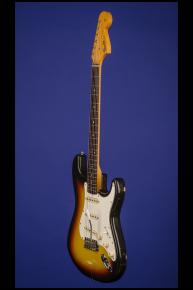A First Generation, Large-Headstock 'Hendrix' Stratocaster
1966 Fender Stratocaster.
This first generation, large headstock Stratocaster weighs just 7.50 lbs. Solid alder body, contoured on back and lower bass bout. One-piece maple neck with a nut width of just under 1 5/8 inches, a scale length of 25 1/2 inches and a very comfortable medium neck profile. Veneer rosewood fretboard with 21 original medium-jumbo frets and pearloid dot position markers. Single "butterfly" string tree. Large headstock with 'Transition' logo with "Fender" in gold with black outline, "STRATOCASTER" in black beside it, "WITH SYNCHRONIZED TREMOLO" in black below it, and two patent numbers "2,741,146", "3,143,028" and "DES 169,062" below that. Individual 'double-line' Kluson Deluxe tuners with oval metal buttons and "D-169400 / Patent No." stamped on the underside. Four-bolt neck plate with serial number "169691" between the top two screws. Three single-coil light grey bottom pickups with staggered polepieces and nicely matched outputs of 5.94k, 5.85k, and 5.87k. The undersides of the pickups have "11-28-66 1", "11-28-66 3" and "12-5-66 6" written in ink. Three-layer plastic pickguard (white/black/white) with eleven screws and full-size aluminium 'shield' on the underside. Three controls (one volume, two tone) plus mid seventies five-way selector switch, all on pickguard. White plastic Stratocaster knobs with greenish gold lettering. Fender "Synchronized Tremolo" combined bridge/tailpiece. The neck is stamped in black "13 SEP 66 B"; the potentiometers are all stamped "304 6610" (Stackpole, March 1966). The original three-way pickup selector switch (in case pocket) has been professionally replaced with a mid-seventies five-way switch. This can easily be reversed if required. There is a two-inch 'scrape' on the top of the body between the bridge/tremolo assembly and the lower strap button. There is an area of belt buckle wear on the back of the body and a few surface marks or chips on the top and sides. The frets appear to be original and show very little wear. There is some minor finish checking and the top right-hand corner of the tremolo cavity cover has chipped away. Overall this is a very good looking and all original (except for the changed pickup selector switch) first generation 'Hendrix' Stratocaster. Complete with the original white plastic tipped tremolo arm. Housed in an original but slightly later Fender black hardshell case with black leather ends and dark orange plush lining (8.75). This guitar sounds absolutely amazing and plays like a dream…
"The Stratocaster was launched during 1954 [and was priced at $249.50, or $229.50 without vibrato]...The new Fender guitar was the first solidbody electric with three pickups [Gibson's electric-acoustic ES-5, introduced five years earlier, had been the overall first], meaning a range of fresh tones, and featured a new-design vibrato unit that provided pitch-bending and shimmering chordal effects. The new vibrato -- erroneously called a 'tremolo' by Fender and many others since -- was troublesome in development. But the result was the first self-contained vibrato unit: an adjustable bridge, a tailpiece, and a vibrato system, all in one. It wasn't a simple mechanism for the time, but a reasonably effective one...Fender's new vibrato had six bridge-pieces, one for each string, adjustable for height and length, which meant that the feel of the strings could be personalized and the guitar made more in tune with itself...The Strat came with a radically sleek, solid body, based on the outline of the 1951 Fender Precision Bass. Some musicians had complained to Fender that the sharp edge of the Telecaster's body was uncomfortable...so the Strat's body was contoured for the player's comfort… Even the jack socket mounting was new, recessed in a stylish plate on the body face...the Fender Stratocaster looked like no other guitar around especially the flowing, sensual curves of that beautifully proportioned, timeless body. The Stratocaster's new-style pickguard complemented the lines perfectly, and the overall impression was of a guitar where all the components ideally suited one another. The Fender Stratocaster has since become the most popular, the most copied, the most desired, and very probably the most played solid electric guitar ever" (Tony Bacon, 50 Years of Fender, p. 18).












